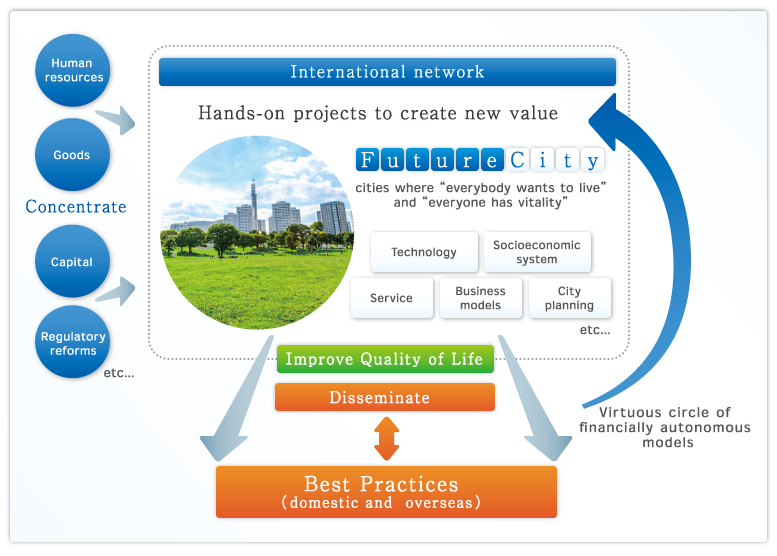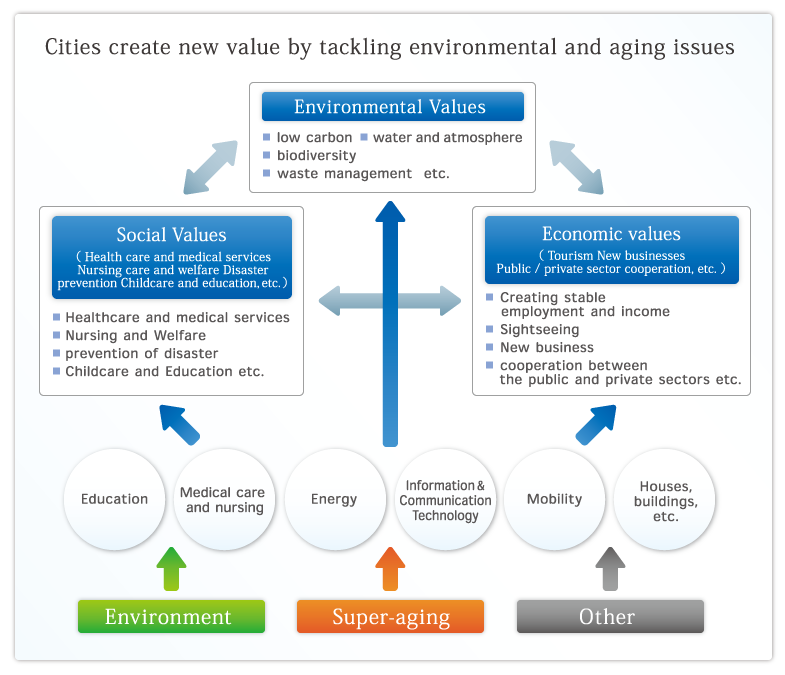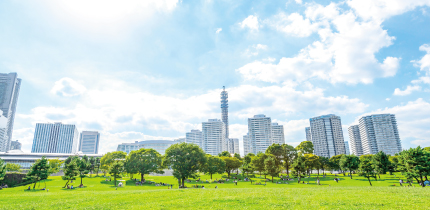Background of the Initiative
Urban populations have increased sharply and now comprise half of the world’s population. This is projected to grow to around 6.4 billion ― 70 % of the world’s population by 2050. This rapid urbanization is seen prominently in developing regions such as Asia and Africa and has caused various environmental and urban problems. The 21st century is referred to as the age of the city. In this age, the challenge of realizing an affluent life without increasing the burden on the urban environment is a challenge common to all human-beings ― a challenge based on an urban perspective.
Japan is known as an “advanced country” in terms of challenges of both a rapidly decreasing birthrate and rapid aging. It is projected that in 2050 seniors over age 65 will comprise 40% of the population. Realizing cities and regions where senior citizens can live a fruitful, healthy and secure life in a vital society is an acute challenge. In the near future, many countries, starting in Asia, are expected to experience this challenge. Therefore, Japan is in a position to first tackle this problem and to offer solutions to the common human challenges.
In this context, it is extremely important to mutually recognize the problems, to pose the problems in a general way, and to think about the framework for solutions to such common human challenges as the environment, aging and revitalization of societies and economies.
The Japanese government identified the “FutureCity” Initiative (hereinafter “Initiative”) as one of the National Strategic Projects in its “New Growth Strategy” in June 2010. The objective of this initiative is to challenge common human problems and to try to propose model solutions as a forerunner.
Purpose of the Initiative
The purpose of the Initiative is to select a few cities as “future cities,” to realize world-leading successful cases in terms of technology, socioeconomic systems, services, business models and city building in order to resolve common 21st century human issues such as the environment and aging, and to disseminate them not only within Japan but also to the world. The ultimate goal is to achieve a revitalized and sustainable society with a new socioeconomic system.
The selected cities are expected to lead to innovations in socioeconomic systems that can create successful cases. The Japanese government will support the selected cities by concentrating related budget appropriations on them, effecting deregulation and reforming the legal and tax systems.
To realize the Initiative, it is important to adopt an open-source innovation strategy which is open both at home and abroad. This strategy is aimed at sharing various experiences, developing intellectual networks, and disseminating the successful cases both inside and outside Japan, at the each development stage in creating concepts, planning and developing technologies and systems and realizing them.

Basic concept of the Initiative
The basic concept of the Initiative is to realize “human-centered cities while creating new values to resolve the challenges of the environment and aging.” It is first necessary to solve global challenges such as global warming, resource and energy limits, and super-aging by establishing sustainable socioeconomic systems as well as by recovering social solidarity. Secondly it is necessary to realize cities where “everybody wants to live” and “everyone has vitality” as well as cities that create new values continuously. Thirdly, we must increase the quality of life of the people.
To realize a sustainable society, considering the value of the environment, society and economy is essential. The “FutureCity” where “everyone wants to live” and “everyone has vitality” is defined as a city where the value of the environment, society and economy is innovatively enhanced, based on the premise that a minimum level of value in each of these three areas has been satisfied.

Future vision and Efforts of individual cities of the “FutureCity” Initiative
The selected cities are to set the strategic future vision in accordance with the abovementioned basic concept in ways that will maximize the total of environmental, social and economic value. When setting the future vision, it is important to adopt both a “backcasting” approach of looking back from the targeted future ideal and a “forecasting” approach of looking forward from the present situation to enhance feasibility. Moreover, it is important to set the vision in a way to maximize city’s attractions, showing their variety and originality as well as their unique natural and social resources.
The selected cities have to tackle challenges of the environment and aging as a minimum requirement and then can take on such additional challenges as increasing their originality and comparative advantages. The selected cities are expected to tackle challenges in cooperation with other cities both inside and outside Japan. It is important to gather worldwide wisdom by absorbing other cites’ successful cases all over the world, to integrate various efforts in different areas to realize synergistic effect, with the goal of socioeconomic systems where value is created continuously. This process should be more than just a real-world experiment and should lead to real innovations. By creating successful cases continuously and outgrowing subsidy dependence, the cities are expected to acquire a self-financing independence and establish financially autonomous models applicable both inside and outside Japan.
A scheme to promote “FutureCity” Initiative
Three important elements are necessary to make the Initiative a success: implementation of steady project management, establishment of a powerful and speedy executive organ, and strengthening cooperation between cities.
In the Initiative, three areas of project management are crucial: how to promote the Initiative effectively, how to manage all projects in individual cities, and how to monitor progress of each project. Steady project management employing the PDCA cycle in each of these areas will increase the possibility of success.
It is essential to have a powerful and speedy executive organ to create successful cases and disseminate them both inside and outside Japan. The national government will not only give advice to the cities but also establish a promoting system to coordinate financing, deregulation and various reforms. The selected cities will form a consortium with corporations, universities and local governments.
Improving successful cases and speeding up dissemination will be realized through strengthening cooperation among cities. The national government will construct an international intellectual platform by collecting, arranging and analyzing worldwide successful cases, disseminating them, and holding international forums for intellectual exchange. The selected cities will exchange successful cases with other cities both inside and outside Japan by utilizing the abovementioned platform as well as deepening cooperation with those cities continuously, including the exchange of citizens.

Introduction of actions of EMCs
"Low-carbon society seems like out of touch with reality to me...!" Responding to this kind of requirement, EMCs demonstrate the concrete image of low-carbon society we should realize in future. Japanese government selected cities that challenge pioneering initiatives in pursuit of ambitious goals and provide support for their implementation. 20 cities have been selected so far.
Promotion Council for the Low-Carbon Cities(PCLCC)
For the purpose of spreading the excellent cases of efforts by EMCs and send relevant Information worldwide, PCLCC was established in December 2008.





